
Synodontis acanthomias is a species of upside-down catfish native to the Congo Basin of Cameroon, the Central African Republic, the Democratic Republic of the Congo and the Republic of the Congo. It was originally discovered by George Albert Boulenger in 1899 in Boma, in the Democratic Republic of the Congo. The original specimen resides in the Natural History Museum in London. The species Synodontis pfefferi, described by Franz Steindachner in 1912 was found to be the same species. The specific name "acanthomias" means "very spiny", a reference to spines found on the side of the fish's body.
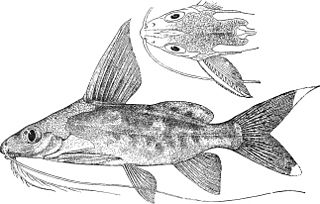
Synodontis alberti, the bigeye squeaker, Albert's syno, bigspotted squeaker, or high-fin synodontis, is a species of upside-down catfish native to the Congo Basin of Cameroon, the Democratic Republic of the Congo and the Republic of the Congo. It was originally described in 1891 by Belgian ichthyologist Louise Schilthuis after its discovery in the Malebo Pool of the Congo River.
Synodontis aterrimus, known as the network synodontis, is a species of upside-down catfish that is endemic to the Democratic Republic of the Congo where it is found in the middle Congo Basin. It was first described by Max Poll and Tyson R. Roberts in 1968. The original specimens were obtained in Bokuma, on the Congo River in what is now the Democratic Republic of the Congo. The species name aterrimus means "very black", referring to the dark coloration on the underside of the body.

Synodontis batesii is a species of upside-down catfish native to rivers of Cameroon, the Democratic Republic of the Congo, Equatorial Guinea and Gabon. It was first collected by G. L. Bates and described by Belgian-British zoologist George Albert Boulenger in 1907, based upon holotypes discovered in the Dja River, near Bitye in Cameroon. The specific name "batesii" refers to the name of the collector of the first specimen.
Synodontis camelopardalis, known as the giraffe synodontis, is a species of upside-down catfish that is endemic to the Democratic Republic of the Congo where it is only known to occur in the Tshuapa River. It was first described by Max Poll in 1971. The original specimens were obtained in Eala, on the Ruki River in the central Congo River Basin. The species name camelopardalis refers to the giraffe, Giraffa camelopardalis, in reference to the coloration of the fish.
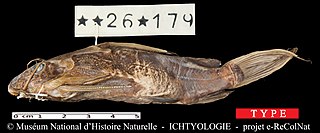
Synodontis centralis is a species of upside-down catfish that is endemic to the Democratic Republic of the Congo where it occurs in the middle Congo Basin. It was first described by Max Poll in 1971. The original specimens were obtained in Ndwa village, Kunungu, Zaire. The species name centralis refers to its habitat in the central Congo Basin.
Synodontis cuangoanus is a species of upside-down catfish that is native to Angola and the Democratic Republic of the Congo where it occurs in the Kwango River drainage. It was first described by Max Poll in 1971. The original specimens were obtained in Cuango, Cafunfo, in what is now the Democratic Republic of the Congo. The species name cuangoanus is derived from "Cuango", the location where the species was first discovered, and the suffix -anus, meaning "belonging to".

Synodontis depauwi is a species of upside-down catfish that is endemic to the Democratic Republic of the Congo where it can be found in Stanley Pool. It was first described by British-Belgian zoologist George Albert Boulenger in 1899, from specimens collected in Stanley Pool, in the Democratic Republic of the Congo. The species name depauwi is in honour of the "conservateur des collections de l'Université libre de Bruxelles", Louis De Pauw.
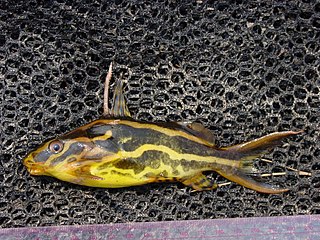
Synodontis flavitaeniatus, known as the orangestriped squeaker, the chocolatestriped squeaker, the yellowstriped squeaker, and the pyjama Syno, is a species of upside-down catfish native to the Democratic Republic of the Congo and the Republic of the Congo where it is found in the lower and central Congo Basin. It was first described by Belgian-British zoologist George Albert Boulenger in 1919. The holotype was collected from the Ruki River at Eala, in the Democratic Republic of the Congo. The meaning of the specific name "flavitaeniatus" is "yellow stripes".

Synodontis greshoffi is a species of upside-down catfish native to the Congo Basin of Cameroon, the Democratic Republic of the Congo and the Republic of the Congo. It was first collected by M.A. Greshoff in Pool Malebo on the upper Congo River, and the species was named for him by the author of the first paper written about the species, Belgian ichthyologist Louise Schilthuis, in 1891.

Synodontis katangae is a species of upside-down catfish that is native to the Democratic Republic of the Congo and Zambia where it is found in the Congo Basin. It was first described by Max Poll in 1971. The original specimens were obtained in Lukonzolwa, on Lake Mweru, in what is now the Democratic Republic of the Congo. The species name katangae is a reference to the Katanga province in the Democratic Republic of the Congo, where the species was first found.

Synodontis longirostris, known as the eyespot synodontis, is a species of upside-down catfish that is native to the Democratic Republic of the Congo where it occurs in the Congo Basin. It was first described by British-Belgian zoologist George Albert Boulenger in 1902, from specimens obtained in the Ubangi River at Banzyville. The species name longirostris comes from the Latin word longus, meaning "long", and the Latin word rostrum, meaning snout, referring to the long snout on this species.

Synodontis nigromaculatus, known as the spotted squeaker, the blackspotted squeaker, or the speckled squeaker, is a species of upside-down catfish that is found widely in southern Africa. It has been identified in Angola, Botswana, the Democratic Republic of the Congo, Mozambique, Namibia, South Africa, Zambia, and Zimbabwe. It was first described by British-Belgian zoologist George Albert Boulenger in 1905, from specimens collected in Lake Bangweulu in Zambia.

Synodontis notatus, known as the onespot squeaker, the one-spot synodontis, or the domino syno, is a species of upside-down catfish native to the Congo Basin of the Democratic Republic of the Congo, and the Republic of the Congo. It was first described by French zoologist Léon Vaillant in 1893. The specific name "notatus" comes from the Latin word for "marked", as with a spot.
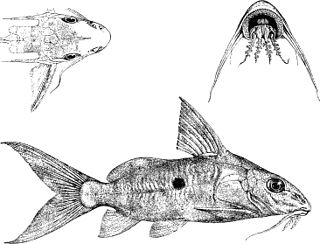
Synodontis nummifer, known as the two spot synodontis, is a species of upside-down catfish native to the Congo Basin of Cameroon, the Democratic Republic of the Congo and the Republic of the Congo. It was first described by the Belgian-British zoologist George Albert Boulenger in 1899, based upon a holotype discovered in Léopoldville, Belgian Congo. The specific name "nummifer" comes from the Latin for "to bear a coin", which refers to the large spots on its sides.
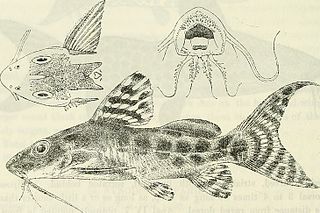
Synodontis ornatipinnis, known as the barfin synodontis, is a species of upside-down catfish that is native to the Congo Basin of the Democratic Republic of the Congo and Zambia. It was first described by British-Belgian zoologist George Albert Boulenger in 1899, from specimens collected in Mbandaka, on the Congo River in what is now the Democratic Republic of the Congo. The species name ornatipinnis means "ornate fins".
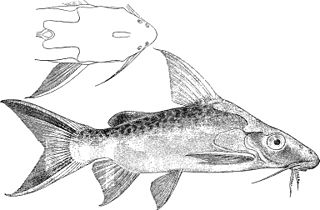
Synodontis pleurops, known as the Congo squeaker, the bigeye squeaker, or the bug eyed synodontis, is a species of upside-down catfish native to the upper Congo Basin of Cameroon, the Democratic Republic of the Congo and the Republic of the Congo. It was first described by the Belgian-British zoologist George Albert Boulenger in 1899, based upon a holotype discovered at the Boyoma Falls, in the Democratic Republic of the Congo.

Synodontis schoutedeni, known as the yellow marbled Synodontis, is a species of upside-down catfish native to the Congo Basin of the Democratic Republic of the Congo and the Republic of the Congo. It was first described by Belgian ichthyologist Lore Rose David in 1936, based upon a holotype discovered in Basongo, in what is now the Democratic Republic of the Congo. The specific name "schoutedeni" is named after the Belgian zoologist Henri Schouteden.

Synodontis serratus, known as the shield-head squeaker, is a species of upside-down catfish that is native to the Nile basin of the Democratic Republic of the Congo, Egypt, Ethiopia and Sudan. It was first described by German naturalist and explorer Eduard Rüppell in 1829, from specimens obtained near Cairo, Egypt. The species name serratus comes from the Latin word serra, meaning "saw", which refers to the serrated pectoral spines of the species.

Synodontis smiti, known as the longtail Synodontis, or Smit's Synodontis, is a species of upside-down catfish that is endemic to the Democratic Republic of the Congo where it is found in the middle and upper Congo Basin. It was first described by British-Belgian zoologist George Albert Boulenger in 1902, from specimens obtained in the Ubangi River at Banzyville. The species name smiti is named for Pierre Jacques Smit, who illustrated the plates in Boulenger's works.


















